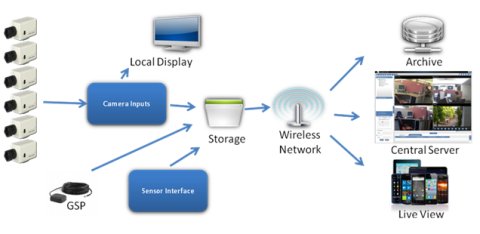Montu Rathod, Senior PES Engineer, eInfochips Ltd
Introduction
Surveillance and security has become increasingly important during modern days for government/law enforcement, public or private transit authorities and for the fleet management. To monitor or investigate accidental damage, theft, harassment or left packages, producing/collecting evidences and analyze the occurrence of situation is challenge. This white paper describes how smart transit solution can generate evidences and help in analyze the situation of an incident. Smart transit solution improves profitability by enabling batter safety, security and service.
Centrally managed, controlled and monitored transit can be the solution. This solution is made possible through collaboration of multiple technologies like video processing, analytics, wireless communication, GPS navigation, data storage and video management server. Collection of meaningful and tamperproof data also helps against false claims.
Major component of this solution is analog/digital cameras, CAN interface, Sensor input like Accelerometer, Temperature sensor and GPS, Storage media and Wireless network router or cellular modem. The information stored from various input can further be transferred and archived to central repository for further analysis by management server.
Below diagram gives illustrate the solution.

Video and audio data from multiple cameras are stored to media along with inputs from GPS, accelerometer, temperature sensor and custom inputs. CAN interface is key interface to get vehicle statistics – like speed, turn indicators …etc. All the data is stored in encrypted format to avoid any tempering of data. Timely synchronized sensor data with video is important evidence and data to analyze any situation. While we have captured and stored a bunch of useful data points, it is important to relay this information to enable critical decision making. Device will be connected to centralize location for real-time data with the help of available Wi-Fi hotspot and/or Cellular network infrastructure.. Alternatively, offline transfer can be arranged at journey endpoints to retrieve the recorded data. Viewing of live video and GPS data can be used for central server for tracking and monitoring.
This solution can be extended to function like driver authentication, people counting, text and signboard detection, lane detection, motion detection. Also by identifying location and time this solution can be extended for advertisement and entertainment purpose with help of local display connection. Traffic monitoring can added advantage for redirecting transport vehicle to appropriate route.
With the help of sensor inputs event based recording can be triggered which will help in analyze any accidental situation. This solution also helps for training and driver behavior monitoring and enhancement. Along with analytics the fleet can be maintained and operated at very high level of efficiency.
With the help of GPS location the nearest vehicle can be found to optimize the travel cost. Two way communications can be done with Driver using underlying communication network.
Vehicle breakdown can also be addressed immediately as the control unit is in communication with the central operations center. Crisis and hostage situations can be managed and monitored with such a solution.
One can use night-cameras and a local display screen to clearly see the path ahead and reduce risk of accidents.
Another use-case would be dynamic route update. Take a situation where a section of the route is not functional due to an accident or heavy traffic or any other reason. This information can be relayed to the locomotive driver and an alternate best-route can be informed from a central monitoring station and displayed with directions on the local screen with navigation.
Combination of various technologies like video processing, wireless communication, GPS navigation, data storage and video management server with mobility can have various use cases to make the transit safe, secured and efficient.